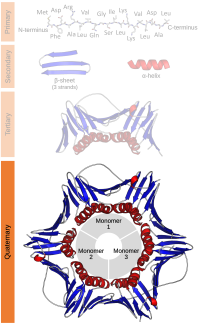Protein oligomer

Protein oligomers are like toy blocks that are made up of smaller units called amino acids. Imagine you have a bunch of different colored toy blocks and you want to make a big tower. You can stack the blocks on top of each other to make a single tall tower, or you can arrange multiple smaller towers next to each other to make a big structure.
Protein oligomers work in a similar way. They are made up of multiple identical or slightly different protein units called subunits. These subunits can be arranged in a linear chain (like a single tower) or they can come together in different arrangements to make a bigger structure.
The number of subunits in an oligomer can vary from two to several hundred. Just like how different toy blocks can be combined in different ways to make different structures, subunits can come together in many different combinations to form different oligomers.
Protein oligomers have many functions in the body. They can act as enzymes that catalyze chemical reactions, transport molecules across cell membranes, or serve as building blocks for larger structures like the cytoskeleton.
Ultimately, protein oligomers are complex and fascinating structures that are crucial for many biological processes. They are made up of subunits that come together in different ways to form larger structures, just like how toy blocks can be combined to make different structures.
Protein oligomers work in a similar way. They are made up of multiple identical or slightly different protein units called subunits. These subunits can be arranged in a linear chain (like a single tower) or they can come together in different arrangements to make a bigger structure.
The number of subunits in an oligomer can vary from two to several hundred. Just like how different toy blocks can be combined in different ways to make different structures, subunits can come together in many different combinations to form different oligomers.
Protein oligomers have many functions in the body. They can act as enzymes that catalyze chemical reactions, transport molecules across cell membranes, or serve as building blocks for larger structures like the cytoskeleton.
Ultimately, protein oligomers are complex and fascinating structures that are crucial for many biological processes. They are made up of subunits that come together in different ways to form larger structures, just like how toy blocks can be combined to make different structures.
Related topics others have asked about:
